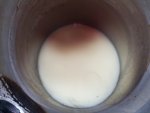This is a picture of the hydraulic fluid after I pulled the rod out of dipper cylinder. Clearly the situation is not good. I think I have no option, but to drain the fluid, and put new in. I have not been able to find any documentation on the procedure to drain it. Admittedly I haven't done an exhaustive search. Do any of you know the correct procedure?

I know there are places that will flush it, but I am sure it will be expensive and I will have to figure out how to get it there and back.
If I try and do it myself, this is what I have been thinking. I will try I and put the cylinders in positions where the lowest part of the cylinder will have the bulk of the fluid. Then drain out the main tank, and disconnect the hoses, and drain the cylinders. Then the hoses from the pump. Possibly then put the intake line in some kind of container to try to flush it out. I am less certain of where to go from there. I don't want to contaminate the new fluid, but what level of flushing will be good enough.
I don't know know as FLU Farm says, I have a habit of over thinking things, but I would like your feed back on what my next steps should be.



